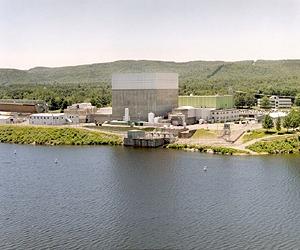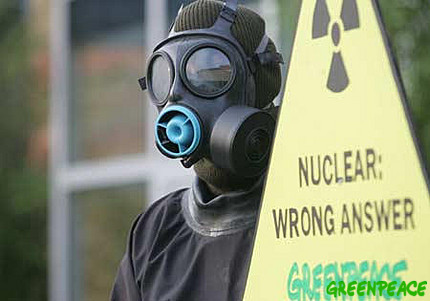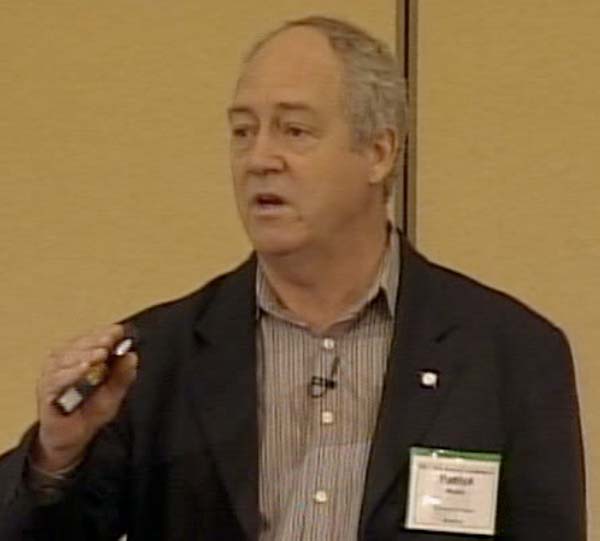Moore Spin: Or, How Reporters Learned to Stop Worrying and Love Nuclear Front Groups
 "We just find it maddening that Hill & Knowlton, which has an $8 million account with the nuclear industry, should have such an easy time working the press," concluded the Columbia Journalism Review in an editorial in its July / August 2006 issue.
"We just find it maddening that Hill & Knowlton, which has an $8 million account with the nuclear industry, should have such an easy time working the press," concluded the Columbia Journalism Review in an editorial in its July / August 2006 issue.
The magazine was rightly bemoaning the tendency of news outlets to present former Greenpeace activist Patrick Moore and former EPA chief Christine Todd Whitman as environmentalists who support nuclear power, without noting that both are paid spokespeople for a group bankrolled by the Nuclear Energy Institute (NEI). NEI represents nuclear power plant operators, plant designers, fuel suppliers and other sectors of the nuclear power industry. Hill & Knowlton is NEI's public relations firm, though it's not the only firm working to build support for nuclear power.
Thanks in part to an ongoing, multifaceted PR push -- along with very real concerns about energy prices, rising energy demand, aging infrastructure, sustainability and global warming -- nuclear power is attracting serious attention from reporters and policymakers alike. The question is whether a vital public debate over energy choices is being skewed by deep-pocketed interests with a dog in the fight.
The dangers of such distortions are especially acute at the state and local levels. That's where efforts to extend the licenses of existing nuclear power plants, to maintain or expand nuclear waste storage facilities, and to site new proposed nuclear power plants, are made or broken. And that's where pro-nuclear campaigners appear to be focusing, adopting the mantle and tactics of community groups while steadfastly refusing to provide details on their operations.
Persistence Pays Off
All manner of businesses promote themselves every day, but the nuclear power industry's need for good PR is tremendous. No new nuclear plants have been ordered in the United States since 1979, the year of the Three Mile Island meltdown. The Yucca Mountain national repository for nuclear waste -- originally scheduled to open in 1998 -- is now slated to begin accepting waste in March 2017. Experienced nuclear engineers are becoming scarce; nearly 30 percent of the industry's workforce "will be eligible to retire within five years," the Scripps Howard News Service reported in April 2006. And even with what one Forbes columnist described as "all this corporate welfare," potential "investors remain wary of construction risks" for new nuclear power plants, explained an energy sector analyst.
The industry's future is so precarious that Exelon Nuclear's head of project development warned attendees of the Electric Power 2005 conference, "Inaction is synonymous with being phased out." That's why years of effort -- not to mention millions of dollars -- have been invested in nuclear power's PR rebirth as "clean, green and safe."
The nuclear power industry has been promoting itself as part of the solution to global warming for a decade. Industry representatives appeared en masse at a 1998 climate change conference in Buenos Aires, according to environmental consultant Alan Tate. "They inundated the international negotiators, including with what appeared to be a number of front groups like Students for Nuclear Power," he told reporter Liz Minchin. By 2005, nuclear industry spokespeople were "giving much more polished performances at climate meetings and negotiations."
 Entergy, which owns and operates 10 U.S. nuclear power plants, has worked with the PR giant Burson-Marsteller for at least five years. In April 2002, Entergy's communications director told O'Dwyer's PR Daily that the firm had been hired "mainly for the Indian Point issues" -- the security and environmental concerns raised by the company's Indian Point nuclear power plant, located outside New York City -- "but its work now includes handling the overall image of the company." In 2003, Entergy created the "Coalition Against Shutting Down Vermont's Electricity Options" and spent $200,000 to oppose a citizen campaign to close the company's Vermont Yankee nuclear plant in 2012.
Entergy, which owns and operates 10 U.S. nuclear power plants, has worked with the PR giant Burson-Marsteller for at least five years. In April 2002, Entergy's communications director told O'Dwyer's PR Daily that the firm had been hired "mainly for the Indian Point issues" -- the security and environmental concerns raised by the company's Indian Point nuclear power plant, located outside New York City -- "but its work now includes handling the overall image of the company." In 2003, Entergy created the "Coalition Against Shutting Down Vermont's Electricity Options" and spent $200,000 to oppose a citizen campaign to close the company's Vermont Yankee nuclear plant in 2012.
And then there's NEI, which exists to do PR and lobbying for the nuclear industry. In 2004, NEI was embarrassed when the Austin Chronicle outed one of its PR firms, Potomac Communications Group, for ghostwriting pro-nuclear op/ed columns. The paper described the op/ed campaign as "a decades-long, centrally orchestrated plan to defraud the nation's newspaper readers by misrepresenting the propaganda of one hired atomic gun as the learned musings of disparate academics and other nuclear-industry 'experts.'"
In January 2006, NEI signed an $8 million contract with Hill & Knowlton. The objectives included developing "a national coalition that would 'activate and expand on' existing nuclear energy supporters, engaging employees, shareholders, academics, health experts, and environmental organizations," and "'pre-empting and offsetting' criticism from opponents," wrote the Holmes Report. With the firm's help, NEI launched what is possibly its greatest PR triumph, almost exactly two years after the op/ed controversy.
Building the Nuclear CASE
The Clean and Safe Energy Coalition (CASEnergy) held its inaugural press conference on April 24, 2006, just two days before the 20th anniversary of the Chernobyl nuclear power plant disaster. CASEnergy is fully funded by NEI, and supported by Hill & Knowlton, along with the polling firm Penn Schoen & Berland.
CASEnergy is not the first business-funded coalition to support nuclear power. In May 2001, the U.S. Chamber of Commerce formed the Alliance for Energy & Economic Growth, "to support proposals that boost [energy] supply, promote investment in the energy infrastructure, encourage alternative energy sources and efficiency without mandates, and fund programs to help low-income energy consumers." The pro-nuclear alliance, whose steering committee includes NEI, hired former Congresswoman and Vice Presidential candidate Geraldine Ferraro to lobby for the Yucca Mountain waste repository. But the alliance never received the attention that CASEnergy is now enjoying.
 That's due in large part to the choice of Patrick Moore, a media-savvy and polarizing figure, as CASEnergy's co-chair and most public spokesperson. As he explained at the group's launch, Moore's role is to "speak and write to press the group's agenda, as well as to coordinate efforts," reported Nucleonics Week. His past work with Greenpeace has proved an irresistible hook for many reporters, even though his association with that group ended in 1986. Moore has now spent more time working as a PR consultant to the logging, mining, biotech, nuclear and other industries (since at least 1991, or 16 years) than he did as an environmental activist (from 1971 to 1986, or 15 years).
That's due in large part to the choice of Patrick Moore, a media-savvy and polarizing figure, as CASEnergy's co-chair and most public spokesperson. As he explained at the group's launch, Moore's role is to "speak and write to press the group's agenda, as well as to coordinate efforts," reported Nucleonics Week. His past work with Greenpeace has proved an irresistible hook for many reporters, even though his association with that group ended in 1986. Moore has now spent more time working as a PR consultant to the logging, mining, biotech, nuclear and other industries (since at least 1991, or 16 years) than he did as an environmental activist (from 1971 to 1986, or 15 years).
"Part of the thinking, surely, was that the press would peg [Moore and fellow co-chair Christie Whitman] as dedicated environmentalists who have turned into pro-nuke cheerleaders," reasoned the Columbia Journalism Review. The magazine added, "in some stories, columns and editorials, the San Francisco Chronicle, the Boston Herald, the Baltimore Sun, the Richmond Times-Dispatch, the Rocky Mountain News, The New York Times, and CBS News all referred to Moore as either a Greenpeace founder or an environmentalist, without mentioning that he is also a paid spokesman for the nuclear industry."
Both NEI and Moore decline to say how much he's paid; Whitman won't answer that question either. Presumably, the nuclear industry feels it's getting its money's worth. A Nexis news database search on March 1, 2007 identified 302 news items about nuclear power that cite Moore, since April 2006. Only 37 of those pieces -- 12 percent of the total -- mention his financial relationship with NEI.
Industry representatives don't just showcase Moore to reporters. In response to a safety question at a public debate on nuclear power in Madison, Wis., on December 7, 2006, NEI's Lisa Stiles-Shell said, "Patrick Moore, the former co-founder of Greenpeace -- he's now very in favor of nuclear power -- often brings up an example of the Bhopal incident in India, 1986 -- a huge chemical accident. ... It was a disaster. But the response was not, 'We have to close down the chemical industry.' The response was, 'We have to make the chemical industry safer.' And that's exactly what nuclear has done, after Chernobyl and after Three Mile Island." She did not disclose Moore's paid position with NEI. When I asked about it, Stiles-Shell responded, "You can't change his mind with money."
Current Greenpeace leaders and other environmental activists have repeatedly distanced themselves from Moore and questioned his claims. Greenpeace advisor Harvey Wasserman recently wrote, "Moore exaggerates his role in Greenpeace and his credentials as a scientist to serve as a public relations hack." But these protestations have mostly been ignored. When they are raised, Moore dismisses them as further proof of the irrationality of his former colleagues.
Taking It to the States
What debate there has been about Moore's nuclear advocacy has focused on media coverage and national-level issues. Meanwhile, "a large part of CASEnergy's work" has proceeded "at the state and local level," as Nucleonics Week reported in April 2006. "The group is planning four or five 'state-level launches,'" added the trade publication, quoting a low-profile CASEnergy spokesman -- and Hill & Knowlton senior vice-president of corporate communications -- Don Meyer.
"Much of [CASEnergy's] work will be aimed at increasing public backing and winning support at the 'very local level' for plant siting and licensing," Environment & Energy News wrote the same month, also quoting Meyer. In September 2006, National Journal reported that CASEnergy "will hit the road this fall with town hall meetings, local press events, and such in New Hampshire, Iowa, Illinois, and Michigan."
And hit the road they have.
 In October, Patrick Moore headlined a CASEnergy event in Cedar Rapids, Iowa. He was joined by local officials and representatives of business and labor groups at the Duane Arnold Energy Center, the state's only nuclear power plant. Moore "called on Iowans to join the CASEnergy Coalition," according to the group's press release, which referred to the event as "Iowa's CASEnergy kick-off."
In October, Patrick Moore headlined a CASEnergy event in Cedar Rapids, Iowa. He was joined by local officials and representatives of business and labor groups at the Duane Arnold Energy Center, the state's only nuclear power plant. Moore "called on Iowans to join the CASEnergy Coalition," according to the group's press release, which referred to the event as "Iowa's CASEnergy kick-off."
Some "15 members of the Iowa House of Representatives Democratic caucus back the [CASEnergy] coalition," reported the Cedar Rapids Gazette. One legislator told the paper that "the coalition doesn't necessarily expect its efforts to yield another nuclear plant in Iowa," but the state's "first-in-the-nation presidential caucuses put the group in a position to influence a change in national energy policy." That's surprising, as federal policy already provides billions of dollars in nuclear industry subsidies, including for new nuclear power plants.
Moore was in Detroit the following month, calling on "Michigan residents to join the CASEnergy Coalition." That event was billed as CASEnergy's "Michigan kick-off" and also included a state legislator and representatives of local business and labor groups. Crain's Detroit Business noted that the pro-nuclear event came as the state's public service commission was readying its comprehensive energy plan for the governor.
Patrick Moore has been much busier than these -- the only events listed on the CASEnergy website -- suggest. He's brought his pro-nuclear road show to at least 10 other U.S. cities since last April. (See related SourceWatch article.) And CASEnergy isn't the only industry-funded group talking up nuclear power around the country.
In November 2006, Moore traveled to Yonkers, N.Y., to support extending the Indian Point nuclear power plant's license until 2035. Also appearing at the pre-Thanksgiving event were Entergy staffers, Rudy Giuliani (whose Giuliani Partners firm works for Entergy), and members of the New York Affordable Reliable Electricity Alliance (NY AREA). In January 2007, Moore was in Montpelier and Brattleboro, Vt., to speak with the Vermont Energy Partnership. In February, he returned to New York, to address NY AREA's "2007 Energy Day at Albany."
One Big, Happy, ProActive Family
The New York and Vermont pro-nuclear groups have more in common than Moore's attention. Both list Entergy, which operates nuclear plants in both states, as a member. And both groups' websites were registered by the same Virginia-based PR firm, ProActive Communications.
ProActive has provided other services for NY AREA, including designing the group's website, logo and newsletter, as well as a presentation template and DVD packaging (for a video titled, "The Power Behind a Growing New York"), according to the firm's website. In November, NY AREA promoted a video news release featuring Moore that credits "ProActive production services," along with the broadcast PR firm MultiVu, in its opening frames. (See video below. Around the same time, NY AREA also had an audio news release with Moore, but only MultiVu is listed on the "story summary.")
ProActive Communications provided a similar range of website and design services -- and a very similar look -- to a third pro-nuclear group, the Boston-based Massachusetts Affordable Reliable Electricity Alliance (Mass AREA), again according to the firm's website. Mass AREA's members also include Entergy, which runs the Pilgrim Nuclear Power Station in Plymouth, Mass.
ProActive founder and president Mark Serrano refused to comment on his firm's work for Mass AREA, NY AREA or the Vermont Energy Partnership. After asking me to submit questions by email, he responded that my questions "relate to assumed business relationships. Discussing these matters with you or anyone else is not appropriate."
Yet the role of ProActive Communications and of Entergy is clear. ProActive lists among its specialties "coalition programs," "grassroots mobilizations," and "editorial [media] outreach." ProActive's program director, James Knubel, joined the PR firm after serving as senior vice-president for Entergy Nuclear Northeast. ProActive's Serrano does double duty as NY AREA's president, while ProActive communications director Paul Steidler also serves as NY AREA's media contact. Steidler joined the PR firm after leading the education reform project at the Alexis de Tocqueville Institution, an industry-funded think tank. (Steidler's name and bio were removed from the ProActive website shortly after I contacted the firm.)
NY AREA didn't respond to an interview request. Entergy spokesperson Jim Steets confirmed that the company was "instrumental in the founding of New York AREA," but said he didn't know "how much of New York AREA's funding comes from Entergy." He added, "There's no question that there's a strong association" between Entergy and NY AREA, but as "membership has grown, we've become just another dues-paying member." NY AREA is comprised of "independent-minded people, with interests of their own," he stressed.
Steets described ProActive Communications' work for NY AREA as: "If there are events or messages, things that we should attend or that people who agree with us might want to attend, ProActive is helpful in organizing the grassroots campaign that would demonstrate that there are people who subscribe to this [NY AREA's] mission. They're skilled in grassroots organizing and advocacy, very similar to what the groups who oppose us do."
Phillip Musegaas, a staff attorney at Riverkeeper, a New York-based environmental group that opposes the Indian Point plant, disagrees. NY AREA and similar groups "do the public a disservice by the fact that they're subsidized by Entergy," he said. "We're straighforward with our campaign, on the other side." Musegaas added, "Exelon, Entergy and other large companies have a lot of money to spend on PR. They do that directly with Burson-Marsteller and Giuliani Parnters, and less directly with these local groups."
Mass AREA communications director Joyce McMahon explained that her group is "not tied to NY AREA" and is "not just about nuclear issues." She verified that ProActive Communications does consulting work for Mass AREA, but declined to describe that work. McMahon also confirmed that Entergy helps fund Mass AREA, but said the group's other members also contribute, each giving an amount relative to its size.
Vermont Energy Partnership executive director Amanda Ibey also stressed that her group isn't focused solely on nuclear power. In an email, she wrote, "We have prepared a number of issue briefs on such topics as hydro power, energy efficiency, nuclear power, LICAP [incentives to keep New England-based generators], transmission infrastructure, and wind power." Ibey described the group as "member-funded" and would not comment on its relationship with ProActive Communications. She did explain that Patrick Moore "is paid by the group" as an adviser, but the "terms are proprietary. We do not work with the Clean and Safe Energy Coalition."
An Industry-Driven Grassroots
Are Vermont Energy Partnership, Mass AREA and NY AREA Entergy-funded astroturf, or fake grassroots groups? Each publicly lists its membership, including Entergy, on its website. And each counts among its members local businesses, unions and individuals that presumably don't stand to benefit directly from policies favorable to nuclear power.
Of course, all businesses, groups and individuals have the right to organize and express their views. But the negative impact of this nuclear industry-driven PR is already clear. Plans to build new nuclear power plants are inching forward, while serious questions and concerns -- not to mention alternative energy policies -- receive little attention. On March 8, the Nuclear Regulatory Commission issued its first site approval for a new nuclear plant in over 30 years. Exelon now has 20 years to apply for a license to build a new reactor in Clinton, Ill.
Entergy and NEI spend millions of dollars doing media outreach, under their own names. Both spend millions more to lobby federal officials. From 1998 to 2004, Entergy spent $13.5 million and NEI spent $9.7 million on federal lobbying, according to the Center for Public Integrity's LobbyWatch database.
But both, while using solely their own names, failed to garner significant public support. So both formed "coalitions" and "alliances," designed to deliver essentially the same pro-nuclear message. Unlike the funders behind classic front groups, NEI and Entergy admit their role in CASEnergy or NY AREA, Mass AREA and Vermont Energy Partnership, respectively. But that disclosure is done in a whisper, with a nod and wink, and sloppy reporting takes care of the rest.
The end result is the same -- instead of a fully informed and vigorous public debate on complex energy issues, the United States is having a lopsided discussion. And the nuclear power industry isn't just dominating it; it has several seats at the table.
Diane Farsetta is the Center for Media and Democracy's senior researcher.
Many of the links in the above article are to articles on SourceWatch, the Center for Media and Democracy's collaborative online encyclopedia. SourceWatch volunteer editors can help update, expand and improve these or any of the other SourceWatch profiles of people, issues and groups shaping the public agenda. It's free to sign up, and we'd love to have you join us.





Comments
Is the Truth Allowed?
Global warming is a reality. Air pollution including tons of Mercury dumped into the air by coal plants is a reality. Coal mining accidents and black lung are a reality.
Nuclear power is safe. Look up the statistics on the industry. Read past the endless hype given by rabid anti-nuke people. Look at the actual statistics. Compare the safety record to any other industries statistics for safety. I think you'll be impressed.
I've worked at nukes. I don't now. I receive no compensation of any kind from them, yet I still think they are a good idea. How many of the anti nuke people have actually worked at nukes? Consider the source of information when reading about nukes. People are criticized for being supported by nuclear organizations. These organizations are those who have the facts. The Sierra Club does not operate nuclear power plants.
Nuclear power plants have been operating in this country since the 1950s. Think of how much pollution has been avoided by their use. Think of how much pollution can be avoided if we had more nukes. Jeepers, the solution to Global Warming is at hand and the US is not taking advantage of this solution.
Politics and environmental PR cannot change reality. The reality is that nukes are needed and more should be built.
(I hope the use of the word Jeepers was not politically incorrect.)
Have you worked in a coal mine?
If people who haven't worked in nuclear power shouldn't criticize that industry, should people who haven't mined coal criticize coal?
Would you have us ignore the fact that nuclear power consumes two non-renewable resources, namely fuel and waste storage capacity?
Are you including Three Mile Island in nuclear power's safety record?
We don't need more nukes; we need to learn more frugal habits, we need to conserve, and we to need invest in energy storage technology and renewable, decentralized and locally appropriate energy sources.
Shilling for nukes
Beth Wellington, Roanoke, VA
http://360.yahoo.com/beth_blog
See:http://www.llrx.com/extras/nuclearenergy.htm